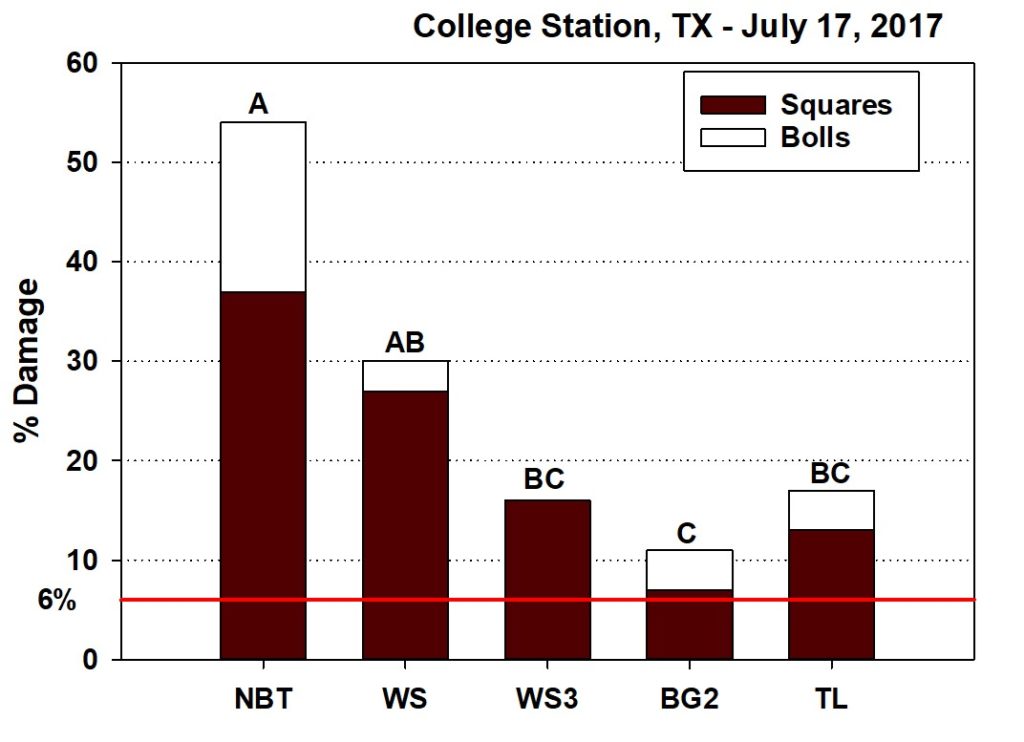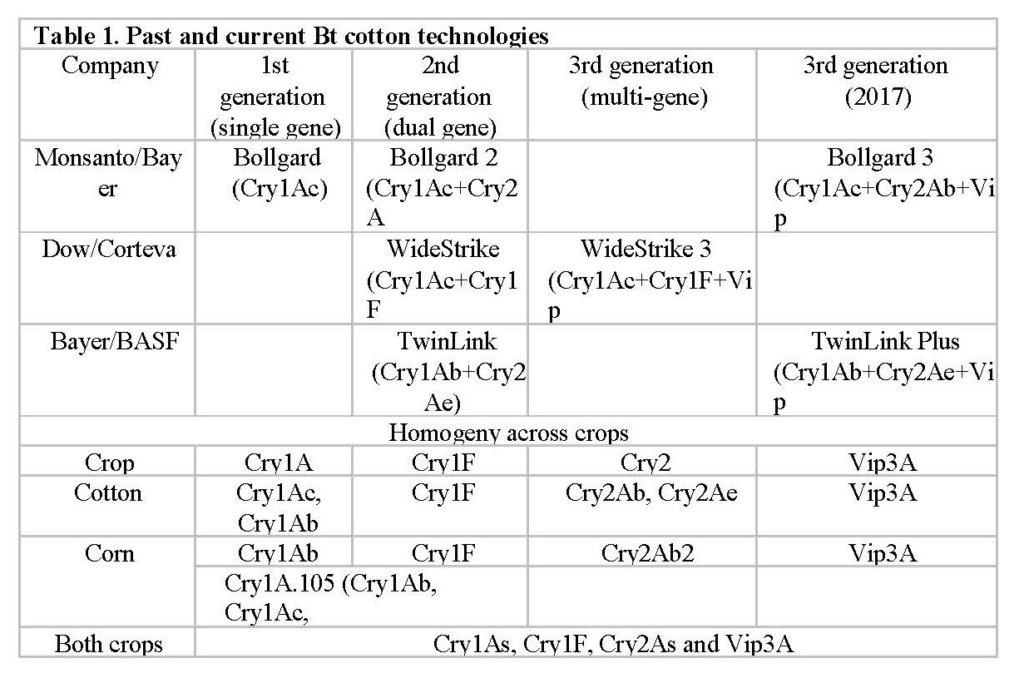by John L. Few IV, IPM Agent in Southern Blacklands and Dr. David Kerns, Extension Entomologist in College Station
Cotton and corn are major cash crops in Texas with a market value of over 3 million dollars combined in 2016. With this much money at stake, producers are looking for methods to ensure their crops will be successful. Cotton bollworm (Helicoverpa zea) is a major pest in cotton and cause sever yield losses. In corn, corn earworm (same insect as cotton bollworm) can occasionally cause significant direct yield from feeding, but most often causing losses by providing an entry point for mycotoxins. One of the most popular methods of controlling cotton bollworm/corn earworm is the use of transgenic Bt technologies. Over the years cotton Bt technologies have evolved from single toxin event to multiple pyramided toxins (Table 1), each with different insecticidal genes expressed as a mean to control caterpillar pest. Dual and multi-gene Bt cottons were developed to prevent resistance and expand pest spectrum activity. Because of the overlap between Bt cotton and Bt corn traits, there is great concern regarding selection for Bt resistance in bollworm/earworm.
Cry1Ac (Bollgard) has always been a weak toxin to bollworm, and Cry1F is even less effective. The inclusion of the Cry2 toxins had greatly increased the effectiveness to bollworm. However recently this
pest has developed a resistance to almost every strain of Bt currently in the market. Research conducted at Texas A&M University has shown wide-spread bollworm/earworm resistance to all cotton and corn Bt technologies except for those expressing Vip3A (Table 2). Because of the high frequency of resistance to the Cry toxins, there is a great deal of resistance selection pressure being placed on the Vip3A toxin.
 Resistance to Bts had resulted in unexpected injury events in both cotton (Figures 1 & 2) and corn (Figure 3). Unexpected injury can occur in any cotton technology but is very common in WideStrike, fairly common in Bollgard 2 and TwinLink, and rare in WideStrike 3, Bollgard 3 and TwinLink Plus. Unexpected injury is common in all non-Vip3A corn hybrids, but injury may occur in Vip3A corn hybrids as seen in Figure 3.
Resistance to Bts had resulted in unexpected injury events in both cotton (Figures 1 & 2) and corn (Figure 3). Unexpected injury can occur in any cotton technology but is very common in WideStrike, fairly common in Bollgard 2 and TwinLink, and rare in WideStrike 3, Bollgard 3 and TwinLink Plus. Unexpected injury is common in all non-Vip3A corn hybrids, but injury may occur in Vip3A corn hybrids as seen in Figure 3.

Figure 1. Bollworm injury to cotton in the Brazos River Bottom in 2017. NBT = Non-Bt, WS = WideStrike, WS3 = WIdeStrike 3, BG2 = Bollgard 2, TL = TwinLink. *Red line represents economic threshold.

Figure 2. Comparative bollworm injury of a non-Bt cotton relative to Bollgard 2 and Bollgard 3 in the Brazos River Bottom in 2017. BG2= Bollgard 2, BG3 = Bollgard 3. *Red line represents economic threshold.

Figure 3. Percentage of corn ears with large corn earworms. NBT = Non-Bt, Intrasect = Cry1Ab+Cry1F, Vt2P = Cry1A.105+Cry2Ab2, and Leptra = Cry1Ab+Cry1F+Vip3A.
Although there are no corn earworm management strategies to mitigate injury in field corn, cotton should be scouted and treated with insecticides as needed. Recently, action thresholds have been changed in cotton to reflect problems associated with Bt resistance (Table 3).
 Insecticides that have proven effective for bollworm control in cotton include: Prevathon, Besiege and Blackhawk. Pyrethroids may be effective at times, but in 2018, bollworm resistance to pyrethroids was widespread throughout most of Texas. Additionally, pyrethroids are noted for flaring secondary pests such as aphids and mites. Among Prevathon, Besiege and Blackhawk, Prevathon and Besiege are most commonly used because they offer longer residual control than Blackhawk. Blackhawk will generally provide about 5-7 days control, whereas Prevathon and Besiege will offer 14-21 days of activity depending on the rate. Prevathon and Besiege share a main active ingredient, chlorantraniliprole. Besiege is more concentrated and also contains a pyrethroid. As a rule of thumb, each fl-oz/ac of Prevathon will provide about 1 days activity, whereas Besiege will provide 1 days activity per 0.5 fl-oz/ac. Suggested rates for Prevathon range from 14-21 fl-oz/ac and for Besiege 7.2-10 fl-oz/ac. Where long-residual control is needed, Prevathon should be applied at 19-21 fl-oz/ac, and Besige at 10 fl-oz/ac. If Blackhawk is utilized the suggested rate is 3 oz/ac. In summary, we know that we have to be smarter and more strategic with our pest management practices. Vip3A is the only Bt technology that is consistently effective at controlling cotton bollworm. But bear in mind that other pests such as tobacco budworm, beet armyworm and fall armyworm are still susceptible to all current Bt technologies.
Insecticides that have proven effective for bollworm control in cotton include: Prevathon, Besiege and Blackhawk. Pyrethroids may be effective at times, but in 2018, bollworm resistance to pyrethroids was widespread throughout most of Texas. Additionally, pyrethroids are noted for flaring secondary pests such as aphids and mites. Among Prevathon, Besiege and Blackhawk, Prevathon and Besiege are most commonly used because they offer longer residual control than Blackhawk. Blackhawk will generally provide about 5-7 days control, whereas Prevathon and Besiege will offer 14-21 days of activity depending on the rate. Prevathon and Besiege share a main active ingredient, chlorantraniliprole. Besiege is more concentrated and also contains a pyrethroid. As a rule of thumb, each fl-oz/ac of Prevathon will provide about 1 days activity, whereas Besiege will provide 1 days activity per 0.5 fl-oz/ac. Suggested rates for Prevathon range from 14-21 fl-oz/ac and for Besiege 7.2-10 fl-oz/ac. Where long-residual control is needed, Prevathon should be applied at 19-21 fl-oz/ac, and Besige at 10 fl-oz/ac. If Blackhawk is utilized the suggested rate is 3 oz/ac. In summary, we know that we have to be smarter and more strategic with our pest management practices. Vip3A is the only Bt technology that is consistently effective at controlling cotton bollworm. But bear in mind that other pests such as tobacco budworm, beet armyworm and fall armyworm are still susceptible to all current Bt technologies.
TL/DR: Reliance on dual-gene Bt technologies is no longer effective at consistently controlling cotton bollworm; whereas those containing Vip3A fail to provide good control. Cotton bollworms have developed resistance to pyrethroids to some degree in most of Texas. Prevathon, Besiege and Blackhawk are effective insecticides for managing cotton bollworm populations.

Professor & IPM Extension Specialist
Texas A&M AgriLife Extension Service
Department of Entomology
College Station, TX 77843-2475
dlkerns@tamu.edu
979.845.2516
